ALONG THE RIDEAU
by
James Swift & Co., 1898
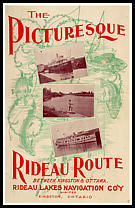 This wonderful piece of prose celebrating the Rideau appeared in "The Picturesque Rideau Route" by James Swift & Co., 1898 (reprinted in 1901 by the Rideau Navigation Company). It was part of a booklet that described the journey up the Rideau aboard the Palace Steamer James Swift (later renamed the Rideau King). Although it contains a few factual errors (the dam at Jones Falls is not 90 feet high, much of the work in building the Rideau was done by French Canadian and Irish labourers, not British soldiers, etc.) it is still a great read. Comtemporary tourist literature about the Rideau pales in comparison to this work. So sit back for an enjoyable read. This wonderful piece of prose celebrating the Rideau appeared in "The Picturesque Rideau Route" by James Swift & Co., 1898 (reprinted in 1901 by the Rideau Navigation Company). It was part of a booklet that described the journey up the Rideau aboard the Palace Steamer James Swift (later renamed the Rideau King). Although it contains a few factual errors (the dam at Jones Falls is not 90 feet high, much of the work in building the Rideau was done by French Canadian and Irish labourers, not British soldiers, etc.) it is still a great read. Comtemporary tourist literature about the Rideau pales in comparison to this work. So sit back for an enjoyable read.
I've included a few photos taken from the 1901 edition.
How many of the tourists who crowd the St. Lawrence steamboats from Montreal to Quebec know that beyond the Martello towers of Kingston there lies an historic waterway, which, for varied natural beauty and the opportunities it affords for sport, fishing, shooting, canoeing and yachting, is simply unrivalled?
Beyond the fact that the British Government spent $5,000,000 sixty years ago in deepening the beds of rivers, connecting a chain of lakes, and building locks and dams, the Rideau is practically unknown. The Lachine Canal had not then made the navigation of the St. Lawrence practicable, and England recognized the need of a means of communication, in the event of war, by which supplies and troops could be conveyed. Its commercial importance has steadily declined, and save for its bi-weekly steamer between Kingston and Ottawa, and a few barges, it has become mainly a pleasure ground for yachts and canoes.
Landing at Cape Vincent from through cars from New York, we cross the St. Lawrence to Kingston, where we take the well-appointed steamer "James Swift " for Canada's capital. For some time travel is on the Cataraqui River, which "winds about and in and out" between sloping wooded shores and rich pasture lands, looking all the while too dainty to bear upon its breast aught more substantial than the light canoe. It is not until the first locks at Kingston Mills are reached that we are reminded that this loveliest of waterways hides its charms from the outside world under the name of the Rideau Canal - canal! Out upon the word; it is such a vile misnomer. Does it not conjure up visions of dreary towing paths, jaded mules and profane drivers? What does the fair Rideau with its woods and hills, its clear, winding streams and water lilies, its foaming cataracts and rockgirt lakes, know of these abominations?
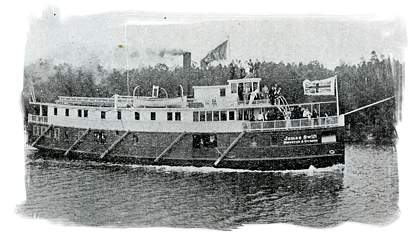
The Palace Steamer "James Swift"
The spires, domes and glittering crosses of Kingston are lost to us now; we are fairly in the heart of the quiet country, with its subdued sounds and sweet scents. An express train of the Grand Trunk thunders over the bridge spanning the locks, and we are distinctly resentful of its intrusion. How we pity the occupants of those cars, with their atmosphere of rush and direct purpose, we happy mortals, who are being slowly raised from elevation to elevation to the music of imprisoned waters.
The locks are marvels of solid masonry and triumphs of engineering skill. They are built of limestone blocks, six feet in length by four feet wide, and of proportionate thickness. Their dimensions are 142 feet by 33 feet in breadth, and from 12 to 25 feet deep. The dams also are of such massive construction that they are well-nigh cyclopean in character. This section of the route being cut through solid rock, necessitated considerable blasting, and it is recorded that 500 men were killed during the process of construction. The work was done by British soldiers, under the direction of the Royal Engineers, and up to 1854, when the canal was transferred to the Dominion Government the lockmen were ex-soldiers of the Engineers or Artillery, wearing military uniform. Above, the locks still stand the square, heavily-built lock houses they occupied, with narrow slits in the walls, through which they could direct their rifles in the event of Indians or unfriendly strangers threatening to impede navigation. Since the day when Colonel By made the first trip on the Pumper, no such event has occurred. Soldiers and Indians have alike disappeared, and the only strangers who linger around the locks are admiring tourists, who do not desire to destroy aught save
FIN, FUR and FEATHERS.
So contiguous were the lakes that in the entire 126 miles it was only found necessary to have six miles of artificial construction, and as this is scattered along the whole route, it is almost impossible to decide where the natural course has been supplemented.
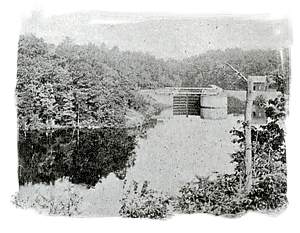 |
| Foster's Lock from Sand Lake |
As the day advances we leave the river and find ourselves in a bewildering maze of wood and water, shut in by hills, from which such a wealth of greenery overshadows us that sunlight only pierces through in fitful gleams, whilst, beyond, the lake glows like a sheet of liquid gold. So narrow is the rocky channel that leaves float down upon us as we pass under the green arcade, and so abrupt are the turnings amid the dense woodland, so full are the shores of delusive bays, inlets and promontories, that the prospect of finding a navigable course seems beyond all reasonable hope. Surely we have fallen under a spell of enchantment, and are destined to sail on and on, until we become literally “ancient mariners,” and the captain of the “Swift” a veritable “ Vanderdecken.” The silence, the softness, the healing balm of nature is around us. Surely “we are the first that ever burst into that silent sea!”
The electricity which lights our boat. the steam that propels it, seem anachronisms. At every turn we expect to see the canoe of the red man. the fitting habitant of those eternal solitudes, as unbroken now as when De La Salle first set foot in the forest primeval. What blessed calm comes to us from the stillness of the woods and hills and far-reaching waters! What infinite rest lies in the distant murmur of a tumbling cascade, in the &oft swish of wavelets washing round our boat! Like a garment that has grown old, world weariness drops from us under nature's touch. Ah, what son of Esculapius can rival her magic powers of healing! What anodyne has pharmacy like that we drink in with her pine-scented air!
Another lake breaks upon us, a sapphire sea, studded with emerald isles; from out the tangled mass of leaf, blossom and vine there flashes the red-winged blackbird, like a streak of flame; the lonely crane pursues his slow heavy flight, and from overhead comes the weird, eerie cry of the loon. Through many isle-gemmed lakes we take our way, each having some distinctive beauty or feature of interest. Cranberry Lake possesses the unusual phenomena of
FLOATING ISLANDS,
which, however, are fully as green and fair as their sisters who rest on a solid foundation.
Although there are several places where tourists can find accommodation, Jones' Falls is the Mecca of fishermen, but as we shall return to it, we linger only to inspect its stupendous horseshoe dam, 400 feet long and over 300 feet thick at the base, and 90 feet high. The four locks, too, cut through solid rock, each lifting the boat twenty-two feet, call for more than passing notice.
We now run through some of the finest fishing grounds in existence, indeed, from this point, noted for its bass and pickerel, to the Rideau River, where maskalonge of from twenty to forty pounds weight abound, the whole route is the paradise of anglers. Black bass were caught this season near the falls weighing six and a half pounds, and pickerel at seven pounds, whilst Oswego. or yellow bass, tipped the scales at eight and a half, and pike at eighteen pounds.
 |
Steamer "Swift" in cut at Chaffey's Lake.
Opposite Idyl-Wild Summer Resort |
Lake Opinicon, once the home of the wild potato, not infrequently yields green bass up to seven pounds. The spotted, strawberry, calico bass, or croppy, as it is variously called, a most toothsome morsel, perch, and other minor members of the finny tribe are also found in great abundance. Of Mud Lake, whose clear waters of aqua marine tint are an absolute contradiction to its name, a story is told which shows, Shakespeare to the contrary notwithstanding, that there is something in a name. Years ago, agents at Montreal, in order to prevent settlers coming to the Upper Provinces by the Rideau, were in the habit of telling them there was a lake of mud on the route, through which each passenger had to assist in shovelling a path for the boat, the soft mass closing in as soon as it had passed. Having in mind the stories told by energetic “runners” during the early days of steamboating on the Hudson, our hearts were moved by this simple touch of nature, and we felt as if we were being drawn very close to our brothers of the Dominion. Courage and originality in mendacity will be appreciated anywhere.
Finally we reach the summit, or highest point on Little Rideau Lake, which differs from the other lakes in being one unbroken sheet of water. Here we are 161 feet above Lake Ontario, which elevation we have obtained by thirteen locks in thirty-eight miles, and must now descend 295 feet by thirty-four locks in eighty-seven miles, to the capital. We now pass into the Big Rideau, the queen of the chain, it being twenty-one miles long and from one to eight miles in width, and having over 200 islands. Until now we had never estimated lakes highly. A river that came from somewhere, and was going somewhere, hustling along as if it had a train to catch, or a bill to meet, or had just been appointed Chairman at a primary, was distinctly entitled to respect. It could tell stories, too, of the mountain heights from whence it had come, of happy country homes past which it had flowed. It whispered of the forget-me-nots and wild violets, and of the butter-cups that decked the lush meadows through which it had meandered. There was an air of hope and expectancy also about it, touching the great ocean to which it was flowing, like poor humanity going out to its eternal sea. But a lake that loafs around home, with its hands in its pockets, so to speak, lacks character, and so we had never cultivated its acquaintance with much earnestness. In the language of the vernacular, there is no “get up” to it. We were conscious, however, of yielding without a protest to the infinite loveliness of the Rideau, as in a dream we saw the thousand isles of the St. Lawrence, Lake George of the States, Scotland's Lomond, England's Windermere, Ireland's Killarney. Italy's Como, and found something here in kinship with them all.
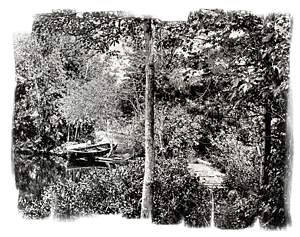 |
| Harbor at Fettercairn Island |
Salmon trout abound in this lake, often gladdening the heart of the fisherman with twenty-five pounds of precious weight. The Marquis of Lorne, who is an experienced naturalist, carefully examined this fish, and pronounced it not a salmon, but a mammoth river trout. Towns and villages are passed at intervals along the route, the whistle of the Swift seeming a tocsin for the gathering of the clans, the result being a heterogeneous mixture of the summer boarder and the native. Here and there a flag tells of summer homes and camping parties, but these add to, rather than detract from the beauty and interest of the journey. The dusk off a summer night falls, and we awake in the morning in the Rideau River, where we pass through scenery of a varied character, notably the famous Hog's Back Cascade. Presently beautiful Ottawa comes in sight, with the delicate spires of her Houses of Parliament, crowning her wooded heights, and keeping ward and watch over the waters flowing at their feet. Here we make a stay, all too brief to do justice to this delightful and most hospitable of cities and its charming people, and return to the “Swift” so as to take in the scenery lost over night. Many tourists bid us adieu at this point in order to take the Ottawa River Line for Montreal.
On the return we see the " Drowned Lands," caused by the building and overflowing of dams. Owing to the abundant growth of wild rice, this district has become the favorite breeding and feeding grounds of wild ducks. Of these the sportsman finds an infinite variety and of a quality to satisfy the epicurean taste of a Lucullus.
THE HOME OF THE WILD DUCK.
Amongst others may be mentioned the native Wood Duck, which builds in hollow trees, the Widgeon, the Bluebill, also native; the Broadbill, the Redhead, the somewhat rare Shoveler, the American Goldeye, the Blue Wing, the Green Wing, the Teal, the Black, the Mallard and the Canvasback. Wild geese are also very numerous. There is a good supply of game in the woods, amongst which are several varieties of snipe, notably the Wilson, dear to epicures, the Partridge, the Yellow-legged Plover and Woodcock. Of larger birds, there are the Baldheaded Eagle, the Great Northern Diver, the Osprey, and others of similar character. Those who wish to penetrate into the deep woods will find Deer, Bear, Lynx, Wildcat, and occasionally a stray Wolf, with abundance of Foxes, Mink, Muskrat, Raccoon, Grey, Red and Flying Squirrels. That interesting animal, the Beaver was once numerous in this district, but the trapper has almost exterminated him. His patiently-constructed dams remain, however, to attest his industry. To those interested in primitive man, Indian remains of considerable antiquity offer a fruitful field for investigation. A fortified village, open-air workshops, arrowheads, gouges, pipes and other remains attest the long residence of the Mississaguas, a sub-tribe of the great Algonquin race. Dr. Beernan. of Perth, an ardent archaeologist, has made many interesting reports to the Canadian Archaeological Society concerning his investigations along the Rideau, and is ever ready to give strangers the benefit of his experience. The writer here begs to tender grateful thanks for his kindness to a weary cyclist who came, to him suffering under the double infliction of sandy roads and semi-tropical sun. Old residents near Oliver's Ferry still remember the ghastly Indian custom of exposing their dead by the shores of the lake until the last vestige of flesh had disappeared, when the bones were removed to the burial ground of the tribe, near Montreal.
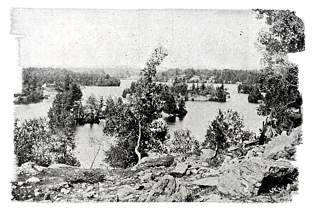 |
| A Few Islands of Lake Opinicon |
We are glad to hear again the torrent of Jones' Falls, and from the vineclad balconies of the De Kenny House watch its snowy waters tumbling over huge boulders into the lake below. This house is so largely patronized by American sportsmen that the astute host flies the Stars and Stripes and the Union Jack side by side. It is a favorite resort for yacht owners, and men of semi-nautical appearance lounge around and exchange fish stories, after the time-honored manner of the imaginative angler. We dearly love the fisherman, not the careless creature who casts a fly and tells you it is all the same to him whether he catches small fry or a record-breaker. May such benighted beings be doomed to whip fishless streams throughout the endless ages. But the ardent disciple of the inimitable Izaak Walton, who would quarrel with his best friend over a matter of half an ounce in the weight of a fish - commend us to that man. Like the typical Englishman, he takes his pleasure with such sad seriousness, his confidence in the gullibility of his confreres is so profound, and his scepticism as to other men's veracity in all that pertains to fishing is so far-reaching.
A sense as of personal possession comes with residence here, and each sojourner, though otherwise amiably disposed, is conscious of an unreasonable desire to protest against new arrivals, saying in effect, with the lover in Tennyson’s “Maud”: “What! has he found my jewel out?” Peace unutterable descends upon us. Stocks may rise or fall, parties triumph or collapse, what care we in this blessed summer land, where it seems always afternoon.
And so the hours pass, until the moon 'rises above the lofty oak-clad hills that shut in our model Castle of Indolence. A call from a dainty little yacht, “The Josie,” loses itself in far-dying and oft-repeated echoes. Lights sparkle from camp and summer cottage, and as a boat swings out from the deep shadowland of the shore, there floats to us over the moonlit waters a verse of “The Maple Leaf,” Canada's national song :—
“And may those ties of love be ours,
Which discord cannot sever,
And flourish green o'er freedom's home,
The Maple Leaf forever.
Then swell the song, both loud and long,
Till rocks and forests quiver,
God save our Queen and Heaven bless
The Maple Leaf forever.”
|